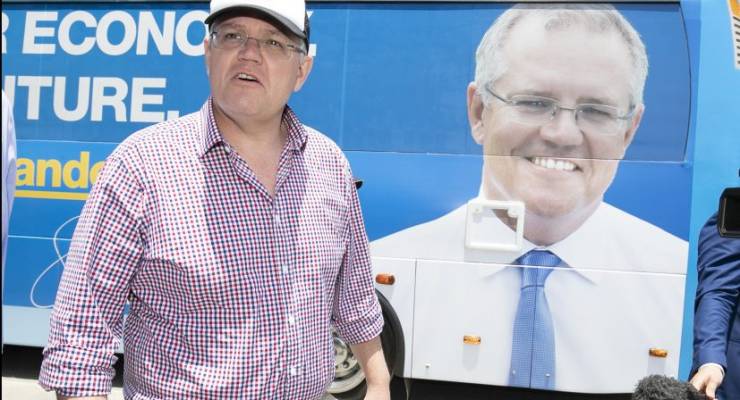
Prime Minister Scott Morrison and his new bus hit the roads of Queensland on Monday to campaign for an election that probably won’t happen for another six months.
Painted various shades of garish blue, the “ScoMo Express”, which is emblazoned with the PM’s grinning mug and promises of “a stronger economy” and “a secure future”, will tour four marginal seats across the state.
The bus itself appears to be another stage-managed attempt to consolidate the Prime Minister’s daggy, fair dinkum, man-of-the-people schtick in a tour which has already seen him eat some strawberries, and film a bizarre video thanking surfer Mick Fanning’s mum for giving him another trucker cap to add to his ever-growing collection.
But the ScoMo Express is also something of a misnomer — for most of the 1500km stretch between the Gold Coast and Townsville, ScoMo will not actually be on board his big blue bus, choosing instead to travel in the comparative luxury of an RAAF VIP jet, for which taxpayers will foot the bill.
Opposition force
The campaign bus has a long and storied history in American politics, making their first recorded appearances in the 1940s. Since then, they’ve slowly become a ubiquitous part of election campaigns around the world. Big, brash and obnoxious, they provide politicians with a moving billboard, and a means of chasing voters around the country.
But the ScoMo Express is particularly bizarre, not only because the election is still so distant, or the fact that it will be largely empty, but also since campaign buses are, in Australia at least, usually used by opposition parties hoping to get their message out, rather than government.
In the lead-up to the Victorian election later this month, opposition leader Matthew Guy has been touring the state on his “Get Back in Control” bus. Unlike the Prime Minister, Guy will presumably actually be on his bus most of the time.

The ScoMo Express also follows on from the wild success of Labor’s “Bill buses” in the 2016 election. Emblazoned with larger than life pictures of Bill Shorten’s face, and spruiking the ALP’s signature “100 positive policies”, the bus, which was initially intended for a two-week blitz of marginal seats between Cairns and Canberra, ended up becoming a key part of the campaign.
Controversial buses
Elsewhere, however, the humble campaign bus has been appropriated for more overtly cynical and ugly purposes.
In the lead-up to the UK’s Brexit Referendum in 2016, the Leave campaign brought out red buses claiming the country gave £350 million per week to the EU, and promising to direct this money back to the National Health Service if successful. That claim, which was crucial to Leave’s narrow victory, has since been called into question.

During the Republican primaries for this year’s Georgia gubernatorial election, state Senator Michael Williams announced a “deportation bus tour”, where he travelled around the state accompanied with a grey school bus inviting intended voters to round up “illegal immigrants”. Despite the brief attention, Williams finished last in the primary race.
And in 2017, Spain’s “bus of hate” travelled around schools in Madrid displaying transphobic slogans.
Still, this is yet more evidence of the undeniable allure of the campaign bus. Buses provide an easy way for politicians to grab attention, conjuring up a blend of old-school, folksy retro appeal and readily meme-able content.
This certainly won’t be the last we see of the ScoMo Express.








Haven’t seen the debt bus in a while.
It’d have to be a road train.
head like a poll
black as your soul
i’d rather vote
to take back control
A stronger economy, a more secure future, for greedy business and no one else.
I know I am a pedant but people should spell it correctly, it is ScuMo
To be fair the current PM is spending very little time on the bus. Mostly it contains only a driver while the PM flies around Queensland. The bus is paid for by the LP but the airfares are picked up by the tax payer.
Full story here: https://www.canberratimes.com.au/politics/federal/ghost-bus-the-scomo-express-hits-the-runway-rather-than-the-road-20181105-p50e2g.html